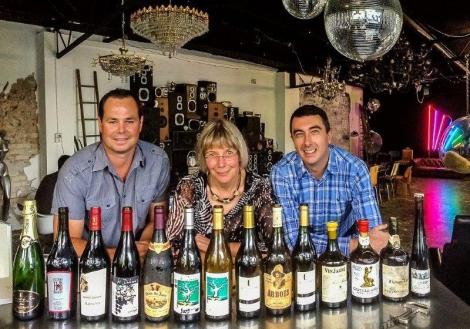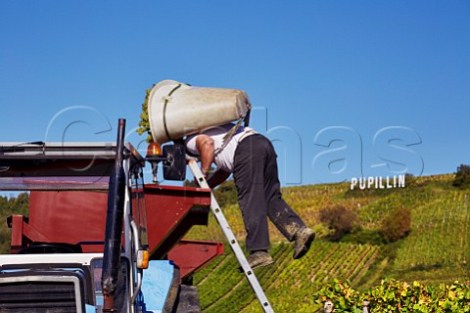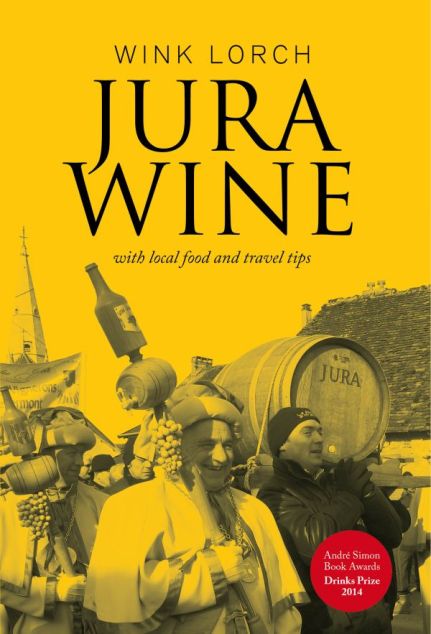A year ago I was far away, working for Wine-Searcher in New Zealand, but keeping an eye on what was going on in the Jura wine region and on how its wines were continuing to make waves around the world. I had the chance to present my book at dinners and tastings in New Zealand, Australia and in the US – it was great fun to meet Jura wine lovers everywhere.

An amazing line-up for an extraordinary tasting dinner in Sydney with Greg Murphy and Shannon Noble © Brett Jones
I returned to Europe in May and since then have made a few brief trips in the Jura, attended tastings in Paris and London and, once harvest was underway, discovered generally an upbeat mood in the region. And, I’ve been selling my book well in the local Jura bookshops. What follows in an update on what’s going on in the region. And, if you don’t have my book yet, or want to give a copy as a gift, please scroll to the bottom of this post for a very special offer!
What was most notable during the year was how much press the little Jura wine region received, especially given its tiny size. Could this be a fashion, many asked? Was it all my doing, because of the book, queried some? My answer to these questions could be no and no, but more accurately it should be ‘partly’. Exports have leapt from 7% to 10% and that’s with a series of small vintages too, and the buzz has grown and grown. For more on this see my thoughts over on Wine Travel Media.
Changes: the old guard moves on and newcomers keep coming
As widely reported, last December Jacques Puffeney let the cat out of the bag (early apparently according to his importer Neal Rosenthal) that he was selling most of his vineyards to Domaine du Pélican, the Jura estate owned mainly by Guillaume, Marquis d’Angerville. Since then I’ve visited with both Jacques and with François Duvivier of Pélican to taste the 2014s and discuss the changes. The fact is that Jacques had no successors and needed to sell. Negotiations to sell to his US importer and vigneron Michel Gahier just didn’t work and the offer from d’Angerville (with whom I know he had been talking since long before Pélican took on its first vineyards in 2012) was simply better. As Jacques used his personal name on his labels and not that of a domaine, the name on the label evidently stops with his last vintage – the 2014. Some of his 2014 wines have been recently released, others will take longer, notably the Vin Jaune for release no earlier than 2021, but it is resolutely Jacques who will shepherd them to bottle as d’Angerville did not buy his stocks.
Domaine du Pélican, who are vinifying wines from Jacques’ vineyards for the first time this year, are likely to keep them separately to begin with – in future they may release individual cuvées. Two things are rarely talked about concerning Pélican – firstly is their complete devotion to getting the best out of their biodynamically run vineyards (those from Jacques are now in conversion) and secondly is that they have many links with local Jura vignerons. Two examples: new plantings are from massal selections from Domaines Pignier and La Pinte; and their manager Rémi Treuvey, is himself a Jurassien from a long line of vignerons. It’s true their first vintages taste perhaps too polished for the Jura, but I say give them time and the vineyards will speak out eventually.
In other moves, Domaine Grand, once believed to be up for sale, has stayed in family hands. Brothers Sébastien and Emmanuel have gone their separate ways, so half the vineyards were sold, but Emmanuel has retained the premises and the business, joining with his partner Nathalie and there seems to be a real enthusiasm there. I have yet to visit. Among those who bought vineyards from Grand are Les Dolomies and Domaine Berthet-Bondet (now with daughter Hélène very much part of the team having completed wine production studies at Montmorot). Rumour has it that Domaine Rolet in Arbois will also stay in family hands, this is yet to be 100% confirmed, but could be good news. The other big, but not entirely unexpected news at the end of 2014 is that the giant Burgundy-based négociant Maison Boisset has taken the majority shares of Henri Maire. It remains to be seen what they will do to improve the wines and re-vamp their terrible shop in Arbois.
In Paris at Le Nez dans le Vert organic tasting in November, along with established participants there were two relative newcomers whose wines I had not tasted. Valentin Morel has now taken over the running of Domaine Morel in Poligny from his father Jean-Luc Morel. He is not only converting the vineyards to organic cultivation, but is also making the wines in an entirely natural way, with no or very low sulphur – he showed a 2014 Trousseau that was juicy, but a touch hard, but a 2015 barrel sample of Chardonnay showed excellent purity. Philippe Châtillon, who years ago ran Domaine de la Pinte, has established his own tiny domaine in Passenans and Arbois, converting the vineyards immediately to organics. In 2014 he also worked without any SO2 as an experiment. I was impressed with his range, especially a deliciously drinkable Pinot Noir named La Grande Chaude. The wines from several other relatively recently-established vignerons go from strength to strength – these include, on the really natural side, Catherine Hannoun of Domaine de La Loue, with an interesting (pale) orange wine named Cuvée Raphaëlle, and Jean-Baptiste Ménigoz of Les Bottes Rouge. Other organic producers, whose ranges are tasting great, include Géraud and Pauline Fromont of Domaine des Marnes Blanches and Patrice Hughes-Béguet.
The 2015 Vintage
Some background first. The last ‘normal’ vintage was in 2011, so growers were keeping everything crossed for 2015, most particularly for decent quantity, though of course everyone cares about quality too. Combining vintages 2012 and 2013 for some organic producers produced the sum of a normal vintage and red wines were in particularly short supply. In 2013, many producers lost much of their Savagnin to a type of pre-flowering coulure that meant future bunches just dropped off the vines due to the very cold early summer. In 2014, the scourge of the Japanese vinegar fly drosophila suzukii wrecked the Poulsard vintage so badly that compromises had to be made – selection wasn’t enough, they had to pick early, ripe or not, or lose the crop and few risked no sulphur additions. The sunny autumn saved the harvest of other grapes thank goodness, but overall no-one had a big crop.

The 2014 harvest was saved by a warm autumn, but it was too late for most of Pupillin’s Ploussard, ravaged by an insect. © Mick Rock/Cephas
In 2015 spring passed with almost no outbreaks of frost or disastrous hail. Flowering was almost perfect (again there were some problems with Savagnin) and once summer came it was dry and hot – very, very close to being too dry and too hot. There was a palpable sense of panic in July as the vines simply stopped functioning, shades of 2003 except that this time there had at least been some winter and spring rainfall. Then, unlike in Burgundy, there was some welcome rainfall in August and the vignerons could breathe again. Hot weather returned, which meant a rush to harvest grapes for Crémant at the end of August and the first days of September. Many admitted it was a little late to catch the decent acidity levels usually required for good Crémant – maybe this means we might have some dryer cuvées from 2015 base – we’ll see. Odd things happened. Trousseau, which is usually the last red to be picked, was showing a potential of 13-14% alcohol at the start of September, before the Poulsard was ripe.
At the end of the day, everyone was smiling at the great quality of all the grapes picked in 2015, with a few concerns about low acidities and some concern about quantity. Oddly the vignerons worried about quantity were those who farm conventionally, or in lutte raisonnée or so-called sustainable agriculture, rather than those working organically. The latter seemed happy, not citing big quantities but – for a change – normal quantities. My theory is that either those working with biodynamic preparations are feeding their vines the forces that can resist drought better, or those who have partly grassed-down vineyards often between every other row, simply suffered from too much competition for the water. These days, most organic growers work with a bare earth principal, ploughing up the weeds and working the soil when needed and this meant no competition for water.
Visiting the Region in 2016 – Dates and Changes
The annual Jura wine festival, the Percée du Vin Jaune will be celebrating its 20th anniversary in 2016 and will be held on February 6th-7th February in Lons-le-Saunier. Attracting 40,000 visitors, many believe this may be the last time the festival will be held in the same format – despite the fees paid by attendees, costs are very high and many wonder whether it is time to change the format.

Arbois remains a gourmet paradise with the Hirsinger chocolate shop in the centre. © Mick Rock/Cephas
The year 2016 is likely to see many changes in the restaurant scene in Arbois. It is believed that Thierry Moyne has sold La Balance; Jean-Paul Jeunet is likely to be retiring, apart from for special events, and handing over to his ‘second’ who he has been working with for many years; Bistrot les Claquets is rumoured to be up for sale. In the meantime, a new restaurant has just opened – Brasserie Aux Docks is on the main square, a few paces from Hirsinger chocolate shop and the many wine shops of Arbois. It will have a short menu, using local/seasonal ingredients – the chef was the ‘second’ at Château de Germigny until this summer. The wine list, to be launched in January (a shorter version is in place right now) will have over 100 Jura wines from over 40 producers, selected by me (there’s the disclaimer), plus a choice of wines from other regions, of course.
I have only recently had a chance to see an enjoyable new addition to the Jura bibliography that came out a year ago – Jura sources & ressources (landscapes & portraits). The photographs and themes are by Serge Reverchon and the text – effectively extended captions – is very competently translated by Caroline Hughes-Béguet, wife of Patrice, the vigneron. For those holidaying in the Jura this book provides plenty of extra ideas of where to visit when you want a break from wine! It’s only available direct from Serge Reverchon or in the local Jura bookshops. And speaking of books …
 Holiday Offer for Jura Wine Book
Holiday Offer for Jura Wine Book
If you would like a signed (or unsigned) copy of the second impression of my award-winning book Jura Wine for yourself or as a gift, then order from Wine Travel Media and use the code NY1625 for 25% discount, valid up to 5th January. Mailing costs are extra and cannot be discounted. If you want the book signed, then please state this in the comments, dedications are not always possible.
The book is available on Amazon but will cost you more! For the electronic versions, click here to order on Kindle or click here for iBooks.





Hi Wink, Thanks for this post, and the news about the new Arbois restaurant. FYI, here’s a link describing our recent trip to the Jura, which was significantly insired and aided by you: http://www.chowhound.com/post/good-food-distinctive-wines-delightful-traveling-jura-1027910 — Jake
Hi Jake,
Thank you for your comment and congratulations on your excellent post – glad you enjoyed discovering the Jura wine region!
Wink